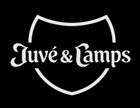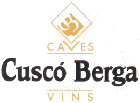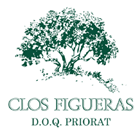Bohigas
by
Kathy and Terry Sullivan
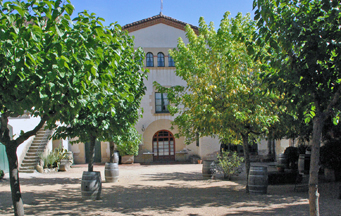 Summary: Bohigas has been growing vineyards and making wine for centuries. Bohigas has extensive enotourism offerings. The family owned and operated winery is located only 45 minutes from Barcelona. Our small group was warmly welcomed to Bohigas.
Summary: Bohigas has been growing vineyards and making wine for centuries. Bohigas has extensive enotourism offerings. The family owned and operated winery is located only 45 minutes from Barcelona. Our small group was warmly welcomed to Bohigas.
Bohigas winery and vineyards are family owned and operated. The property has a beautiful 13th century home. According to Maria Casanovas Giro, this house is a typical Catalonian home. The family planted vineyards in the 13th century and made wine. It was not until the 20th century that the bottling of wine began. Cava production began in 1929.
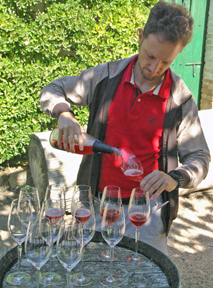 Our tour began at the front of the 13th century era home where we gathered in a courtyard. We were offered a delicious pink/red Bohigas cava to sip while Maria, a Bohigas descendent, told us of the Bohigas family and its journey into wine. The courtyard was filled with trees and even an old wood grape press added to the ambiance.
Our tour began at the front of the 13th century era home where we gathered in a courtyard. We were offered a delicious pink/red Bohigas cava to sip while Maria, a Bohigas descendent, told us of the Bohigas family and its journey into wine. The courtyard was filled with trees and even an old wood grape press added to the ambiance.
Later we walked around the winery property enjoying the adjacent vineyards. As we walked we noticed a small church with a tower. According to Maria, during the 20th century, the Bohigas family wanted to have more contact with the town and added a church to the property. Towards the back of the property we stopped in front of the winery where we enjoyed another glass of wine before entering the winery.
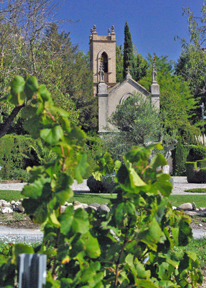 Vineyards
Vineyards
The winery has 35 hectares of vineyards onsite and only five minutes from the winery building. The soil in the home vineyards consists of clay and sand. Another 54 hectares of vines are in another state with its own wine cellar. Grapes are harvested by machine.The vineyards around the estate home include Macabeo, Parellada, Xarel-lo, Cabernet Sauvignon and Syrah.
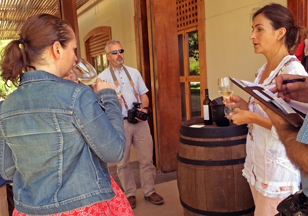 Winery
Winery
Upon reaching the winery, we discovered that each grape variety is fermented separately. We tasted our second wine as Maria told us about the barrel room and winery. We learned that one of their unique attributes is that the winery bottles cavas every month. They believe that bottling every month keeps the cavas fresh. Today Bohigas produces 500,000 bottles of cava and 50,000 bottles of still wine.
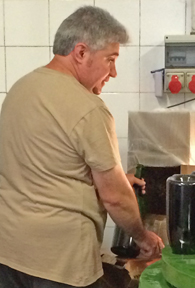 At the time of our winery visit, workers were disgorging magnums by hand. First one worker placed the upside down magnums into a green circular tray that froze the plug near the opening of the bottle. Another worker took the bottle and a bottle opener and removed the cap while aiming into a box. The pressure inside the bottle propelled the frozen plug out of the bottle and into the box. A third worker added a precisely measured dosage to each bottle. The bottles were then corked and caged.
At the time of our winery visit, workers were disgorging magnums by hand. First one worker placed the upside down magnums into a green circular tray that froze the plug near the opening of the bottle. Another worker took the bottle and a bottle opener and removed the cap while aiming into a box. The pressure inside the bottle propelled the frozen plug out of the bottle and into the box. A third worker added a precisely measured dosage to each bottle. The bottles were then corked and caged.
Bohigas is one of the few wineries that has a robot. Not many wineries have robots that can fill pallets and it is even more unlikely to see a robot working. At Bohigas they have one 8-foot tall yellow robot. We saw the robot continuously filling pallets twisting and turning efficiently and never getting tired. For several minutes, our group stared in fascination at the precision and efficiency of the robot.
After our winery tour we returned to the Bohigas home. The home is filled with artifacts of the generations of the Bohigas family. In a sense it reminded me of a small-scale castle with its assortment of decor. We were treated to see a special room (attic) with artifacts not currently displayed. Someone has taken the time to categorize everything. It was fun to wander through the collection.
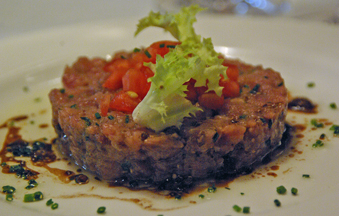 After our tour of the house we sat in one of the rooms for a catered Catalonian lunch that had been prepared for us. We enjoyed the delicious tapas especially the mini hot cakes, bacon, mushrooms and quail egg and truffle oil and dessert.
After our tour of the house we sat in one of the rooms for a catered Catalonian lunch that had been prepared for us. We enjoyed the delicious tapas especially the mini hot cakes, bacon, mushrooms and quail egg and truffle oil and dessert.
Bohigas Cavas and Wines
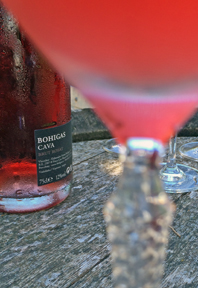 Rosat Cava was produced with the Trepat grape variety. This red cava had 12% alcohol. The cava offered strawberry, raspberry and some citrus notes. The wine was very crisp. The retail price is 8,85€.
Rosat Cava was produced with the Trepat grape variety. This red cava had 12% alcohol. The cava offered strawberry, raspberry and some citrus notes. The wine was very crisp. The retail price is 8,85€.
Xarel-lo 2013 Catalunya DO was a light yellow still wine with 12% alcohol. The wine offered notes of mineral, yellow stone fruit and a bit of lemon grass. This crisp wine retails for 5,7€. Udina 2013 Catalunya DO was produced with Garnacha Blanca, Xarel-lo, and Chenin Blanc. This yellow color wine offered notes of mineral, peach, with lemon on the finish. Udina was the name of the town in the past.
Crianza 2011 Catalunya DO was also a still wine. The wine was produced with Cabernet Sauvignon and Garnacha. The wine was an opaque, dark ruby color. The wine was 14% alcohol. Notes included herbal, cassis, blackberry and vanilla. The full-bodied wine offered bold tannins. Fermi was a blend of Syrah and Samsó. This wine was 14% alcohol. The opaque, dark ruby wine had notes of black berries and plums. The full-bodied wine had bold tannins.
Noa Cava DO was produced with a blend of Pinot Noir and Xarel-lo. This yellow cava with 12% alcohol offered mineral and white peach notes.
Look for Bohigas cavas and still wines. The winery offers extensive wine tourism experiences including:
- Visiting the underground cellars + Wine tasting
- A vineyard experience
- Traditional disgorging experience
- Wine tasting sessions
- Fly over the vineyards and property in a hot air balloon
- Visit the vineyards and property in an all-terrain vehicle
- Gastronomy
- Harvest festival
- Cultural visit
Bohigas
˙Finca Can Macia
08711 Odena
Barcelona, Spain
Article written October 2014
Please support the following.
 |
|||
 |
 |
